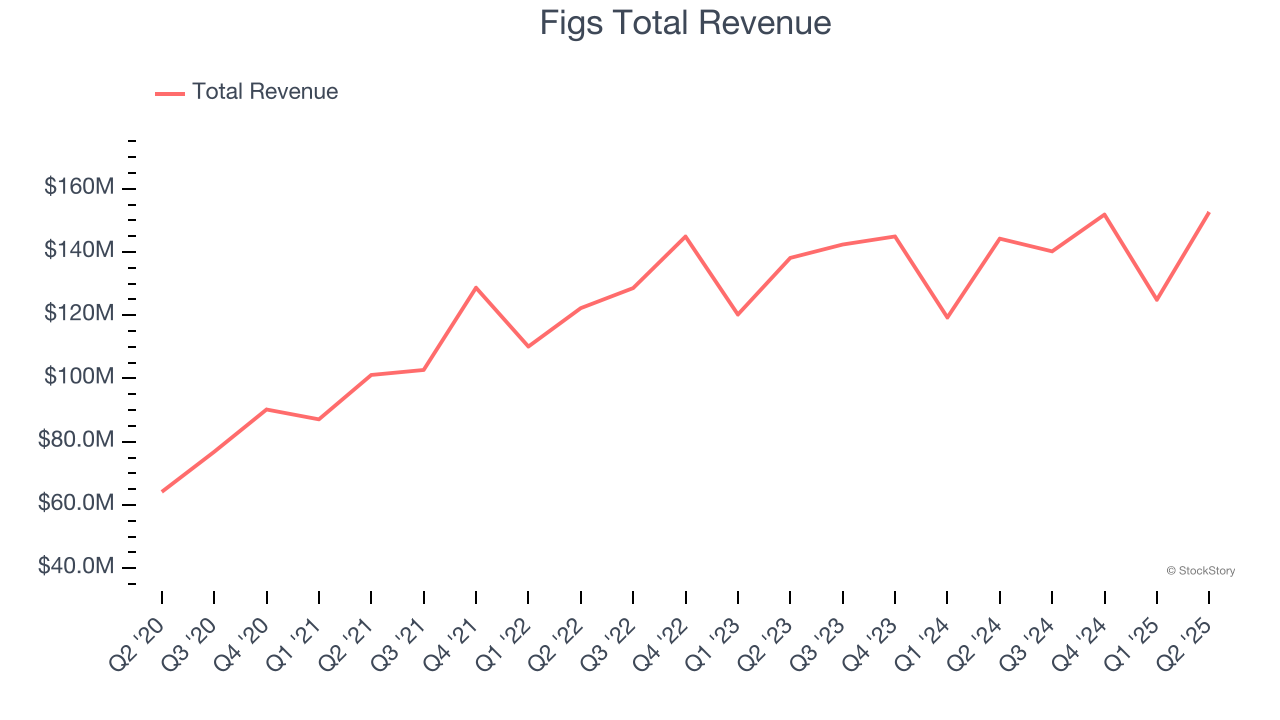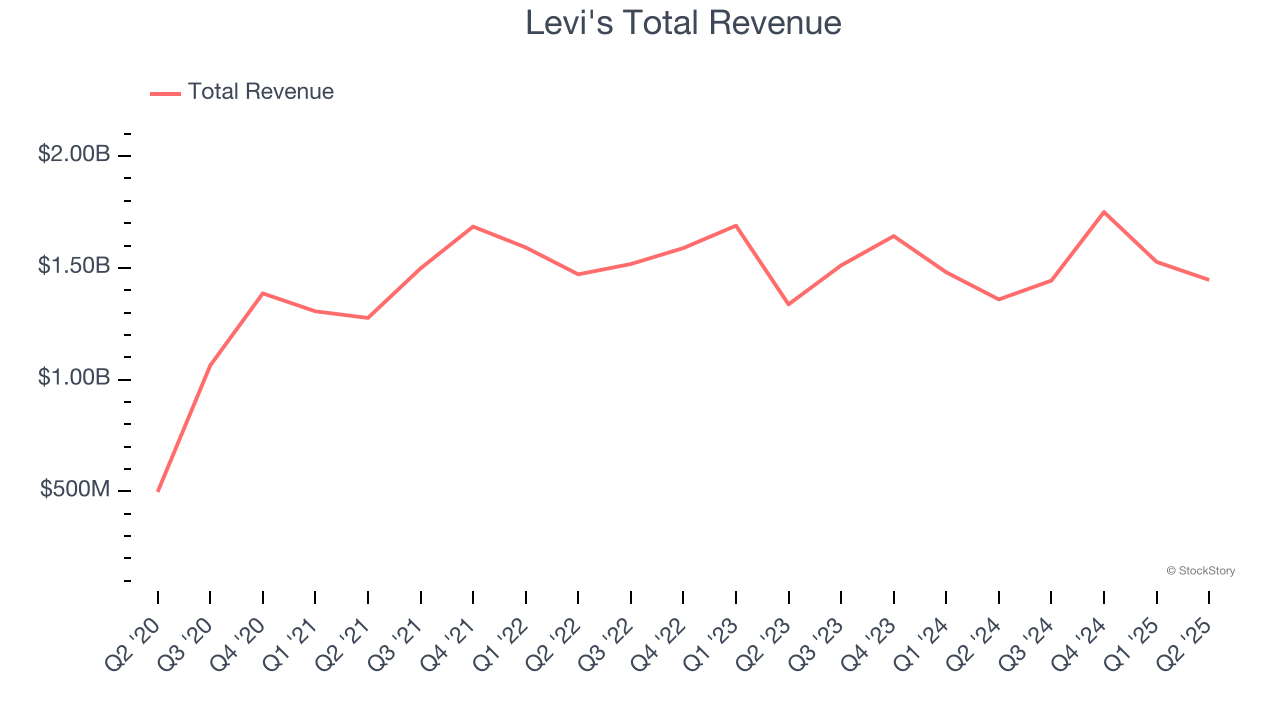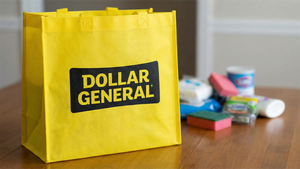
Looking back on apparel and accessories stocks’ Q2 earnings, we examine this quarter’s best and worst performers, including Figs (NYSE: FIGS) and its peers.
Thanks to social media and the internet, not only are styles changing more frequently today than in decades past but also consumers are shifting the way they buy their goods, favoring omnichannel and e-commerce experiences. Some apparel and accessories companies have made concerted efforts to adapt while those who are slower to move may fall behind.
The 16 apparel and accessories stocks we track reported a strong Q2. As a group, revenues beat analysts’ consensus estimates by 3.1% while next quarter’s revenue guidance was 15.4% below.
Luckily, apparel and accessories stocks have performed well with share prices up 10.2% on average since the latest earnings results.
Best Q2: Figs (NYSE: FIGS)
Rising to fame via TikTok and founded in 2013 by Heather Hasson and Trina Spear, Figs (NYSE: FIGS) is a healthcare apparel company known for its stylish approach to medical attire and uniforms.
Figs reported revenues of $152.6 million, up 5.8% year on year. This print exceeded analysts’ expectations by 5.5%. Overall, it was a stunning quarter for the company with a beat of analysts’ EPS estimates and an impressive beat of analysts’ EBITDA estimates.

Interestingly, the stock is up 11.1% since reporting and currently trades at $7.29.
Is now the time to buy Figs? Access our full analysis of the earnings results here, it’s free.
Levi's (NYSE: LEVI)
Credited for inventing the first pair of blue jeans in 1873, Levi's (NYSE: LEVI) is an apparel company renowned for its iconic denim products and classic American style.
Levi's reported revenues of $1.45 billion, up 6.4% year on year, outperforming analysts’ expectations by 5.8%. The business had an exceptional quarter with a solid beat of analysts’ constant currency revenue and EPS estimates.

The market seems happy with the results as the stock is up 12% since reporting. It currently trades at $22.10.
Is now the time to buy Levi's? Access our full analysis of the earnings results here, it’s free.
Weakest Q2: Carter's (NYSE: CRI)
Rumored to sell more than 10 products for every child born in the United States, Carter's (NYSE: CRI) is an American designer and marketer of children's apparel.
Carter's reported revenues of $585.3 million, up 3.7% year on year, exceeding analysts’ expectations by 3.4%. Still, it was a softer quarter as it posted a significant miss of analysts’ adjusted operating income estimates.
As expected, the stock is down 9% since the results and currently trades at $29.77.
Read our full analysis of Carter’s results here.
Guess (NYSE: GES)
Flexing the iconic upside-down triangle logo with a question mark, Guess (NYSE: GES) is a global fashion brand known for its trendy clothing, accessories, and denim wear.
Guess reported revenues of $772.9 million, up 5.5% year on year. This result surpassed analysts’ expectations by 1%. Overall, it was a very strong quarter as it also recorded a beat of analysts’ EPS estimates and a solid beat of analysts’ adjusted operating income estimates.
The stock is flat since reporting and currently trades at $16.75.
Read our full, actionable report on Guess here, it’s free.
Tapestry (NYSE: TPR)
Originally founded as Coach, Tapestry (NYSE: TPR) is an American fashion conglomerate with a portfolio of luxury brands offering high-quality accessories and fashion products.
Tapestry reported revenues of $1.72 billion, up 8.3% year on year. This print topped analysts’ expectations by 2.6%. Zooming out, it was a mixed quarter as it also recorded a solid beat of analysts’ constant currency revenue estimates but a significant miss of analysts’ EPS estimates.
The stock is down 5.9% since reporting and currently trades at $106.87.
Read our full, actionable report on Tapestry here, it’s free.
Market Update
Thanks to the Fed’s series of rate hikes in 2022 and 2023, inflation has cooled significantly from its post-pandemic highs, drawing closer to the 2% goal. This disinflation has occurred without severely impacting economic growth, suggesting the success of a soft landing. The stock market thrived in 2024, spurred by recent rate cuts (0.5% in September and 0.25% in November), and a notable surge followed Donald Trump’s presidential election win in November, propelling indices to historic highs. Nonetheless, the outlook for 2025 remains clouded by potential trade policy changes and corporate tax discussions, which could impact business confidence and growth. The path forward holds both optimism and caution as new policies take shape.
Want to invest in winners with rock-solid fundamentals? Check out our Top 5 Quality Compounder Stocks and add them to your watchlist. These companies are poised for growth regardless of the political or macroeconomic climate.
StockStory is growing and hiring equity analyst and marketing roles. Are you a 0 to 1 builder passionate about the markets and AI? See the open roles here.

















